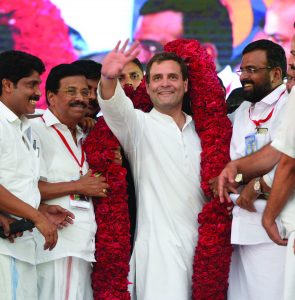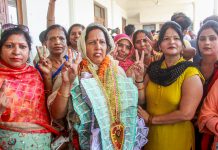 Congress resurgence, December victory in three important Hindi speaking states and the fact that Congress came second in as many as 224 constituencies should because of concern for the BJP. Despite Modi wave, Congress emerged at second slot in 224 seats and BJP attained a whopping and convincing victory, but analysis shows that the BJP could get only about 31 per cent of total votes in the country as a whole.
Congress resurgence, December victory in three important Hindi speaking states and the fact that Congress came second in as many as 224 constituencies should because of concern for the BJP. Despite Modi wave, Congress emerged at second slot in 224 seats and BJP attained a whopping and convincing victory, but analysis shows that the BJP could get only about 31 per cent of total votes in the country as a whole.
Little doubt in elections 2019 that begin from April 11 and end with a second phase on May 19, the Congress is likely to go close with BJP in most of the constituencies in the upcoming Lok Sabha elections. The mathematics behind the 224 seats is based on those states where the Congress bagged top two positions in the 2014 elections, and is still going strong.
In 10 big states, including Gujarat, Karnataka, Kerala and Madhya Pradesh, which account for 224 parliamentary seats, the Congress was at top two positions in 183 seats. However, in 16 small states and Union Territories, which have 28 Lok Sabha seats, the Congress was at top two positions in 27 seats. It should be noted that in Kerala and Maharashtra, the Congress was in alliance with regional parties. In 2014 general elections, the Congress either won or finished as a runner-up in 268 of the total 543 parliamentary constituencies. It won just 44 seats and bagged second position in 224 seats.
The BJP leaders take comfort from the fact that 2014 general election brought to power the first single-party majority in the Lok Sabha since 1984 and the first majority obtained by a non-Congress party, the Bharatiya Janata Party. The Congress suffered its worst defeat in 129 years, much worse than its 1977 defeat, after the Emergency.
This is the worst defeat of the Congress 129 years. It got only 44 seats, with a 19 per cent vote share. In the Hindi heartland, the party was reduced to seven seats, five less than even its previous comprehensive defeat in 1977, when if faced the competition of the entire opposition united behind the Janata Party. Even in 1977, Congress managed to maintain itself in the south and still retained 27 per cent of total vote share.
In 2014, the Congress losses have been comprehensive and complete. A total 484 parties contested the 2014 election, which is 121 more than in 2009 and nearly the double of the number of parties that contested in 2004.
The BJP should know that in terms of vote share, this is the lowest vote share ever necessary to win a majority of seats — 31 per cent. That is to say 31 per cent of 66.4 per cent of votes cast or 139.5 million voters. This comes to 17 per cent of the total voting population. The 2014 majority is the shortest majority obtained by a single majority party.
And mind it, the 2019 general election is not 2014 election which was held on the promise of “achhe din” and anti-incumbency of 10 years of Manmohan Singh government at the Centre. The 2019 polls come after three victories of Congress in Hindi heartland of Madhya Pradesh, Rajasthan and Chhattisgarh. Beyond doubt, the BJP in Uttar Pradesh was undoubtedly the biggest surprise of these elections. The BJP won 71 out of 80 seats, leaving the crumbs to other parties’ leaders.
For the first time since it contested elections, the BSP draw a blank. In terms of vote share, the rise of the BJP was amazing, from 17.5 per cent to 42.34 per cent. Congress collapsed to 7.48 per cent. But then the Bahujan Samaj Party and the Samajwadi Party were on a collision course. The BSP and SP have joined hands and it’s a formidable combination. Then there is the resurgent Congress buoyed by the victories in three Hindi states and induction of Priyanka Gandhi Vadra.
Political arithmetic at times can be very interesting. In the Hindi heartland, for instance, 45 per cent of the votes brought the BJP 86 per cent of the seats while the Congress with 19.5 per cent of the votes got only 3 per cent of the seats. So numbers can be confusing and the BJP should be wary of this logic.
With 172 million votes, the BJP got a vote share of 31 per cent — or nearly every third vote cast in the country — as against the Congress’ 19.3 per cent. But see just 31 per cent of votes meant almost clean sweep by the BJP. In 1999, headed by Atal Bihari Vajpayee the BJP won just 86.6 million votes — 17 million votes less than the Congress — with a vote share of 24 per cent but was able to form the government.
Another interesting fact that emerged from the analysis is that the swing in the vote share away from the Congress was smaller than the swing in the vote share towards the BJP.
In fact, the large vote shares are never a guarantee of electoral success, as both the Bahujan Samaj Party in Uttar Pradesh and the DMK in Tamil Nadu discovered– with 19.6 per cent of the vote and 23.6 per cent respectively in their states, neither party could pick up a single seat.
The BJP converted its votes into seats at a far better rate than the Congress could. The winning party needed on average just over 6 lakh votes to win a seat, while the Congress needed over 24 lakh votes to deliver it one seat. The winning party’s gain since 2009 was almost exactly what the Congress’ loss was. With 282 seats, the BJP won the highest number of seats by a single party compared with 244 for the Congress in 1991 and 206 for Congress it in 2009.
The BJP got more seats than it had in the last two elections combined. It could have formed government on its own, a feat that no party had come close to since the 1984 election which saw a wave of sympathy following the assassination of Congress prime minister Indira Gandhi. The BJP came close to but did not beat the best ever performance of Janta Party that won 295 seats in the 1977 post-Emergency election that drove Indira Gandhi out of office.
How BJP could garner such a brute majority would be known from the fact that it’s biggest win came from Uttar Pradesh, where it won 71 seats despite a big coalition partner, the best performance by a single party in the state since 1984 when the Congress won 83 of 85 seats.
The BJP also improved its vote share in states where it did not have a substantial presence, with vote shares of 22 per cent in Odisha, 17 per cent in West Bengal and over 10 per cent in Kerala. Kerala is now the only big state where the party does not have an MP, while the Congress has no MPs in Gujarat, Himachal Pradesh, Jharkhand, Delhi, Odisha, Rajasthan, and Tamil Nadu.
The BJP consolidated its position in states where it has grown strong, shutting the Congress entirely out of Gujarat and Rajasthan and almost entirely out of Madhya Pradesh and Rajasthan. The Congress lost 37 seats between Tamil Nadu and Andhra Pradesh alone, two states that it had done well in 2009.
Two of the BJP’s main allies — the Shiv Sena and the TDP — performed strongly, while the Akali Dal did not do that well in Punjab and ceded space to the Aam Aadmi Party. The Congress won four seats out of 13 from Punjab despite the Moidi wave. Subsequently in 2017 elections to state assembly, the Congress led by Capt Amarinder Singh won convincingly from Punjab.
The BJP had won 22 seats in Bihar despite going without its major past ally, the JD(U), and a huge tally in Uttar Pradesh despite going nearly solo. The DMK, which left the UPA alliance last year, was wiped out of Tamil Nadu, while the NCP went from eight seats in Maharashtra to four. The Rashtriya Janata Dal was the only ally that performed comparatively and surprisingly well, winning four seats in Bihar.
Now the major fight for the Congress remains in the 10 states of Assam, Chhattisgarh, Gujarat, Haryana, Karnataka, Kerala, Madhya Pradesh, Maharashtra, Punjab, and Rajasthan. These states contribute to 224 of the 543 parliamentary seats. Of the 224, the Congress won only 29 seats and ended at the second position in 154 seats in the last general election.
Among these 10 states, Maharashtra was the only state where the Congress, which was in alliance with the Nationalist Congress Party (NCP), held a major share of seats. The Congress contested only 26 of the 48 seats while the NCP fought the remaining 22. The Congress recently displaced the BJP in Madhya Pradesh, Rajasthan, and Chhattisgarh. The 16 smaller states and Union Territories (UTs), including Himachal Pradesh, Uttarakhand, Goa, and the Northeast hold 28 Lok Sabha seats. The Congress won only five seats in the Northeast and secured the second position in 22 seats in 2014. Except for Sikkim, the Congress was at top two positions in all the seats.
The Congress continues to remain weak in nine states, including Uttar Pradesh, Bihar, and West Bengal, where the regional parties have taken commanding positions. These states account for 291 parliamentary seats — more than half of parliamentary seats. The Congress won just 10 seats and stood second in 48 in 2014. The politics in these states revolves around the regional and caste-oriented parties, and present the biggest challenge for the Congress.
While Congress has not much to lose and only to gain because 44 was its lowest ever tally. The BJP dream of “Congress mukt Bharat” remains a distant reality and its for the BJP to be wary of Congress in the 2019 elections! Relying on “nationalism” in the wake of airstrikes, the jingoism alone may not be enough to revive the Modi wave in 2019. The comfort for the BJP is that Narendra Modi remains the tallest leader in the country and the best bet.
letters@tehelka.com












